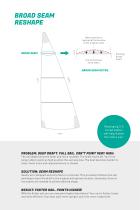
Catalog excerpts

RESTORE SAIL PERFORMANCE WITH A PRECISION RECUT SAIL PERFORMANCE IS SHAPE DEPENDENT Sail shape and minimizing stretch are two key variables in delivering optimum upwind performance and reducing heel and weather helm. These factors also extend a sail’s wind range before reefing or furling becomes necessary and have a big impact on the functionality of sail handling systems. Dacron® sails – even those made with the highest quality sailcloth—are most vulnerable to stretch. Membrane sails are more stretch resistant, which improves long-term shape retention. In both cases, however, shape changes will occur over time, affecting sail performance. Quantum’s Precision Recuts give new life to older sails by restoring the sail up to about 90% of its original shape. Reshaping techniques can be applied to both Dacron® and membrane sails to yield a sail that will allow you to point higher, sail faster, and is easier to trim. The condition of the sailcloth is key; it must not be too worn and stretchy or the adjustments will not produce the desired results. With good fabric, reshaping can generally be done once or twice during the life of a sail. Following, are three of the most common ways to help increase performance and enj
Open the catalog to page 1
BROAD SEAM RESHAPE New seamline is rejoined at the location of the original seam BROAD SEAM Existing broad seam Cut and remove extra fabric BROAD SEAM DETAIL Reshaping 3-5 broad seams will help flatten the entire sail. PROBLEM: DEEP DRAFT. FULL SAIL. CAN’T POINT VERY HIGH. The sail depth becomes fuller and more rounded. The draft moves aft. You’re no longer able to point as high as when the sail was new. The boat becomes harder to steer, heels more and responsiveness is slowed. SOLUTION: SEAM RESHAPE Seams are reshaped and extra fabric is removed. This procedure flattens the sail and helps...
Open the catalog to page 2
LUFF CURVE RESHAPE RED: REDUCE LUFF CURVE GREEN: ADD LUFF CURVE Luff curve can be removed or added to help return sail to original entry shape. PROBLEM: REDUCED ENTRY. SAIL IS HARD TO STEER. As sails age, their entry is reduced due to a variety of factors. Stretch, as well as over-tensioning the halyard can reduce entry. Reduced entry will make the sail harder to trim, less efficient and make steering more difficult (and less fun!) SOLUTION: LUFF CURVE CHANGE Luff curve can be restored to help return the sail to its original entry shape. Sometimes a luff curve change is made to remove entry...
Open the catalog to page 3
LEECH TAKE-UP CUT AND REMOVE EXTRA FABRIC The leech length can be shortened and straightened by removing extra fabric along a seam or elsewhere. PROBLEM: LEECH FALLS AWAY. SAIL ISN’T DELIVERING POWER. On cruising Dacron® mainsails and genoas, the leech can stretch and fall away, making the sail more difficult to trim and reducing boat speed. This is especially prevalent on larger cruising mainsails and mainsails with large roaches. Leech stretch can also hamper the use of furling systems. SOLUTION: LEECH TAKE-UP By removing extra fabric at a seam or elsewhere on the sail, the leech can be...
Open the catalog to page 4
NEW SAIL PERFORMANCE AT A FRACTION OF THE COST Older sails in good condition can be reshaped to return the sail to peak performance at a cost far less than the price of a new sail. Generally speaking, a recut will cost less than 20% of the cost of a new sail. Speak with your local Quantum sail consultant for more detailed pricing. HOW DO I KNOW IF MY SAIL IS A GOOD CANDIDATE FOR RESHAPING? If you are experiencing any of the problems noted above, contact Quantum Sails and we will happily perform a sail shape analysis and provide you with the results and an estimate at no charge. The analysis...
Open the catalog to page 5
TIPS FOR TAKING PHOTOS OF YOUR SAIL FOR RECUT ASSESSMENT 1 Sail must be full, on a close hauled course, trimmed correctly. 2 Photos should be taken from the mid-foot of the sail in question, with the lens aimed at the head of the sail. 3 Rotate the camera to capture the full length of the lowest draft stripe. 4 Take a variety of photos from this location, as well as photos of any specific problem area on the sail. 5 Where practical, take a few photos from the stern of the yacht, with the lens pointed forward toward the bow, and up towards the head of each sail. 6 It is very important to...
Open the catalog to page 6All Quantum Sails catalogs and brochures
-
MAINSAIL TRIM GUIDE
4 Pages
-
IQ Technology Sheet
3 Pages
-
Racing Precision Recut
6 Pages
-
Matte film brochure
4 Pages
-
cruising - woven
4 Pages
-
cruising
4 Pages
-
racing - spinnaker
4 Pages
-
racing
4 Pages
-
210
11 Pages
-
Beneteau First 36.7
1 Pages
-
Fusion_M
16 Pages
Archived catalogs
-
Cruising Sails
11 Pages
-
PROPER SAIL CARE
1 Pages















